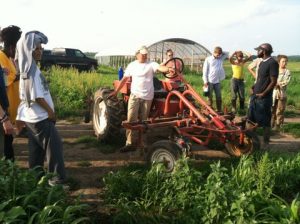Weeds! They are the bane of many organic farmers’ and gardeners’ lives. That’s why The Land Connection held a Weeding Field Day at veteran organic vegetable farmer Henry Brockman’s farm near Goodfield on June 29, 2013.
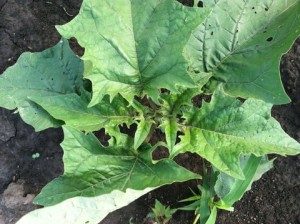
Henry started by talking about his weeding philosophy. He then elicited the “good” roles weeds perform, and also the “bad” – pointing out that good and bad can change according to where and when a particular “weed” pops up.
As he was speaking, he absent-mindedly pulled a weed from the edge of the field, and one of the attendees noticed and asked about it. Henry said it was definitely bad – and that he pulls Jimson weed whenever he sees it because if it goes to seed, those seeds will persist in your soil and give you grief forever. He’s heard stories of old farmhouses or buildings that, after being torn down or burned, sprout jimson weeds all around because those seeds were lying in wait for decades or even a century. Twenty people attended the Weeding Field Day, some experienced growers and some newbies. Five attendees were graduates of Central Illinois Farm Beginnings, and one of those was Justin Turner, a new employee of The Land Connection. Justin is our new Facilitator Assistant for the 2013-14 season of CIFB program, and you’ll be hearing from him now and then in this blog. Here’s what he wrote about his experience of the field day.
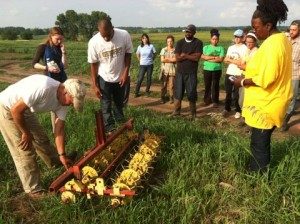
“Being a recent graduate of Central Illinois Farm Beginnings, my mind has been full of plans, ideas, and concerns about my new farming life. Going to Henry’s Farm for the weeding field day was simply inspirational, and it helped to nullify some of my concerns. Before the field day, weeds seemed like Godzilla in the old movies: a big, green menace with an impressive arsenal. Henry’s approach to weeds was so Zen that by the end of the field day, Godzilla had shrunk into the cute lizard from the Geico commercials.”
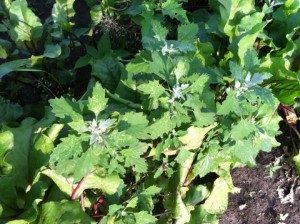
How did this happen? Well, Henry started by asking the group what a weed was. One experienced person said it was a plant in the “wrong place,” and Henry said that was right. A soybean plant in a soybean field is a crop, but a soybean plant in a corn field is a weed. Henry also said that a weed is a plant in the wrong place at the wrong time. It might be ok to have a few foxtail in your tomatoes early in the season, but if they’re about to go to seed, it’s time to consider them a weed and take them out. Henry also pointed out that many weeds are edible, and can be harvested and sold. These “weeds” include lambs quarters, amaranth, and purslane.
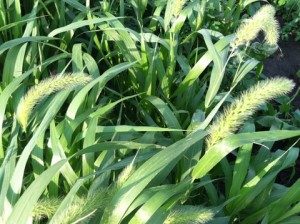
So when are weeds “good” or “bad”? Henry says they’re good any time they aren’t harming your crop, which they generally do by competing for moisture or sunlight. If that isn’t the case, then they are doing a lot of good, adding biodiversity to your field, and drawing up nutrients from deep in the soil, creating organic matter and nutrients that will enrich your soil when you till them down. And you do need to pull or till them down before they go to seed, because if they do, you will be fighting that one weed a thousand times over in years to come. Then the tour and demonstrations began. Henry had positioned various implements and hand tools around the field, and walked and talked, showing and telling and answering questions about each one, from the belly-mounted basket weeder to the slicer hoe.
“Henry’s Zen approach — that weeds add biodiversity and can be beaten without needing a full time chiropractor — was my main takeaway from the field day. Being introduced to the many tools to deal with weeds, from a Tuff Bilt to hand sickles from Japan, created many more paths for me to take on this organic farming journey of mine.”
